Abstract
The study aims at developing and testing a comprehensive scientifically valid and practically convenient sociological and statistical system of indicators for evaluating the socio-economic development of a region. The methodological and procedural framework integrates the minimax method (for the purpose of standardization), the Saaty analytic hierarchy process (for the purpose of integration), statistical and sociological analysis (the authors introduced their own system of objective indicators and developed a sociological questionnaire). The research results are presented in the form of a sociological and statistical system of indicators for analyzing trends in the region’s socio-economic development and the results of system testing for Kemerovo Region (in its statistical part, with the analysis of data for 2003–2018). The theoretical significance of the research consists in the development of a unique analytical framework that allows identifying problem areas of the territory development based on both objective and subjective data, which increases its reliability, provides a comprehensive examination of the trends and phenomena under study. The applied significance is proved by the possibility of practical development of strategic measures aimed at contributing to the socio-economic development of a particular region.
Keywords: Region, sociological and statistical evaluation, social and economic development, integrated modelling
Introduction
Contemporary studies employ a wide range of approaches to the evaluation of a region’s social and economic development level, its various indicators as major targets of regional development, and criteria of regional authorities’ efficiency. Mathematical modelling is the most promising way to describe regional system as a complex array of various socio-economic parameters with diverse relationships between its components. Researchers and experts in regional development issues have developed a number of descriptive, cognitive, econometric and other models interpreting individual sectors of economy, social matters, the standard and quality of living.
For a significant period of time, the authors have been deeply engaged in studying the social and economic development of regions (in particular, industrial ones, based om the case of Kemerovo Region). This study showed that the development of industrial regions follows the pattern common for other Russian, however, at slower growth rates. Besides, the economy of an industrial region proved less stable against crisis fluctuations of the market situation and changes in demand for major products of its industry. For example, during the global financial and economic crisis of 2008, Kemerovo Region recorded significantly greater changes in the unemployment and air emissions compared with national rates. Moreover, population’s income growth rates were much lower, the same was true for education and cultural. Crime rate, on the contrary, tended to rise from 2009 on (Morozova et al., 2018; Mukhacheva et al., 2019).
Approaches to modelling socio-economic development of a region
Russian and international researchers suggest various classifications of mathematical models employed to describe a region’s social and economic development. The models adopted most commonly include:
Models based on interindustry balances are applied in scenario forecasts to build a recurrent model with pronounced dynamics. They employ open statistical data for building (among others) rather complex analyses matrices including intermediate consumption coefficients (Kleiner, 2001).
Econometric models are employed in economically developed countries with an efficient basis of statistical information (for instance, Eurostat). The weakness of such models is the that they are inapplicable for forecasting the development of the regional economy, but can be used only for modelling individual parameters in future periods.
Direct simulation models are usually used in forecasting the development of an enterprise, however, they lack convenient software implementations that include a mechanism for the reallocation of resources through the budget, intersectoral commodity flows, the final consumption, import and export sectors, etc.
Computable General Equilibrium (CGE) models were designed to simulate the establishing of supply and demand optimum in commodity markets, labour market and investment market. Correspondingly, they assume modelling cost of goods, wages and interest rates in financial market. The weak point of such models is their low applicability to describe economic parameters of Russian Federal Districts and the country as a whole based on the data of a single region.
The Prognoz (Forecast) software package is employed by the Ministry of Economic Development and Trade of Russia. The package includes elements of econometrics combined with economic and statistical analysis based on data for previous year. However, it is not applicable to modelling development processes in economically underdeveloped regions (or single-industry areas), where the establishment of one large enterprise changes the entire regional development structure (Guryeva, 2015). Nevertheless, as statistic information is accumulated retrospectively, the Prognoz package may become increasingly demanded (Bisultanova, 2017).
Ismikhanov and Magomedbekov (2016) proposed a model to forecast the social and economic development of the Republic of Dagestan based on the so called “trend models”. As a majority of other methods of forecasting the regional socio-economic development, this one employs one-dimensional approach consisting in the extrapolation of the observed trend to future periods (Eldyaeva, 2006).
Robert Axelrod in 1976 introduced cognitive maps for modelling complex socio-economic systems under the conditions of uncertainty. Kalazhokhov examined the models of social and economic development applying the catastrophic theory and noted the nonlinear logic of the system development (as cited in Arnold, 1990).
Methods for integrating social and economic indicators
Following a number of foreign studies, Russian researchers Egorova and Kostikova (2014) paid attention to dynamic fuzzy set analysis as a means of synthesizing heterogeneous social and economic indicators of regional development.
This method was developed in the works of Zadeh (1976) and aims at processing information based on building dynamic membership functions with recording changes in the specified parameters over time. Kostikova (Egorova & Kostikova, 2014) developed a complex indicator of the social and economic development level synthesizing numerical data and subjective estimates applying linguistic means for marking variables (which form fuzzy sets).
Fuzzy set analysis methods have become widespread mainly due to their intelligibility both to the public at large, the population of a region who do possess special knowledge of terms and methods, and to experts, provided the analysis method has a required scientific foundation. In this case, the convolution of assessments obtained for a single criterion will form the desired indicator. Despite the wide use and proved efficiency of this research method, software products for models based on fuzzy set analysis are being developed at a regrettably slow pace (Leonenkov, 2003).
Problem Statement
Which ways can be suggested to synthesize heterogeneous statistical indicators of the region’s socio-economic development into the whole and bind them with sociologically-obtained data for the purpose of integral assessment?
Research Questions
Which ways can be suggested to synthesize heterogeneous statistical indicators of the region’s socio-economic development into the whole and bind them with sociologically-obtained data for the purpose of integral assessment?
Purpose of the Study
The study is aimed at developing and testing a complex scientific-based and practically convenient system of sociological and statistical indicators for evaluating the region’s socio-economic development level.
Research Methods
Analysis and differentiated selection of indicators of the region’s social and economic development level made it possible to form the appropriate structure of the corresponding indicators grouped into 5 sections: population; economics, production, finance, prices; infrastructure; labour, science and innovation; social aspects and crime. The preliminary statistical analysis covered almost 200 social and economic indicators for the period 2004–2018 (15 years) obtained from the studying of open statistics.
Subsequently, the initial list of social and economic indicators was reduced to comply with the principles of necessity and sufficiency, the availability of indicators in open sources for all periods, convenience of interpretation and comparison, and the priority of choosing relative indicators. In some cases, to obtain relative estimates, the data were recalculated in absolute terms (per capita, in relation to GRP).
To calculate the integrated indicator of a region’s socio-economic development, all individual indicators were divided into two blocks depending on whether it is their increase or decrease that affects the final indicator (interpreted positively).
The division of indicators into two blocks made it possible to apply to each of the blocks specialized formulas for data standardization and unification of dimensions of indicators, which provide a better opportunity for their comparison bearing in mind the fact that some indicators have positive effects on the region’s socio-economic development, while others affect it negatively.
In modern literature, there is an approach to the normalization (standardization) of statistical indicators with the minimax method involving the differentiation of formulas depending on the nature of their influence on the research object (Ayvazyan, 2012). To integrate the data the authors employed the Saaty (1989) hierarchy process which belongs to the methods of fuzzy sets and expert assessments.
The system of weighting factors was determined expertly: the project team involved 6 experts with PhD and Candidate degrees in Economics, who specialize in analyzing socio-economic indicators of the regional development. Expert assessments were checked for consistency, as a result of which some particular expert matrices were removed when calculating general indicators.
The system of weighting factors of life quality indicators thus formed is universal in relation to different regions and time periods. It constitutes the basis of sociological and statistical methodology for evaluating the social and economic development of a region.
A multilevel integration of socio-economic indicators characterizing the region’s social and economic development level in statistical and sociological dimensions was conducted for the purpose of the study. Initially, the integrated indices were calculated for the blocks of indicators which were then integrated when calculating the general indicator of the region’s socio-economic development applying the expert assessment of the weight values (for individual indicators, their blocks and general ones) determined with the Saaty process (Saaty, 1989).
At the stage of calculating integrated indicators for blocks of socio-economic development, statistical data were supplemented with data from sociological research obtained with a questionnaire specifically developed by the authors for this study. Further, the results obtained by blocks in compliance with the same system of weighting factors, determined by experts with the Saaty process, underwent the final convolution to obtain a general integrated indicator of the region’s social and economic development level.
Consider the procedure of sociological data formation in more detail. As it was already mentioned, the questionnaire was used to collect general information about each of the blocks of the region’s social and economic development, described by statistical data. As members of the research team hold such a two-dimensional measurement of the major parameters of the object under study makes it possible to supplement objective data with subjective assessments in some cases providing more reliable information on various aspects of the region’s socio-economic development.
To increase the reliability of sociological data, according to the proposed procedure, their collection should be conducted in two aspects: territorial (by a region and a region’s district) and estimated (data from opinion polls among experts and the general public are used). The integration of the assessments obtained is made by calculating their arithmetic mean (equal weighting factors are assigned to the estimates of the development of a region and a region’s district by experts and by the population). The expert questionnaire developed for a sociological assessment of the socio-economic development level will be published in the authors' monograph (in print). In questions of the questionnaire, each of the spheres of social and economic development corresponds to one of 5 sections of the statistical procedure for their further integration.
The obtained estimates of the ratios of social and economic indicators within the three-level integration (by blocks, sections including sociological data, and calculation of the general integrated indicator) are the result of the final stage in the development of sociological and statistical procedure to evaluate the region’s level of socio-economic development and are universal in nature (i.e., applicable to any territory).
Integration of the data obtained with the indicators of statistical analysis is conducted based on coefficients calculated with the Saaty analytic hierarchy process. The weighting factors of the indicators of the socio-economic development level in terms of blocks and sections are summarized in Table 1.
Findings
The proposed methodology for evaluating a region’s social and economic development level was tested on the case of Kemerovo Region in terms of statistical analysis. Data was collected for 2004–2018 (15 years). Conducting a sociological research requires additional costs and is planned within the framework of further research.
Below, the obtained results of the analysis are discussed by sections and blocks of indicators of socio-economic development.
Population
For this block, Kemerovo Region has equal or close to equal indicators with the Russian national average in 2004–2008. Nevertheless, since the crisis year of 2009, the region has been steadily underrunning in terms of population development, including data on demography, incomes and expenditures of citizens (see Figure 1).
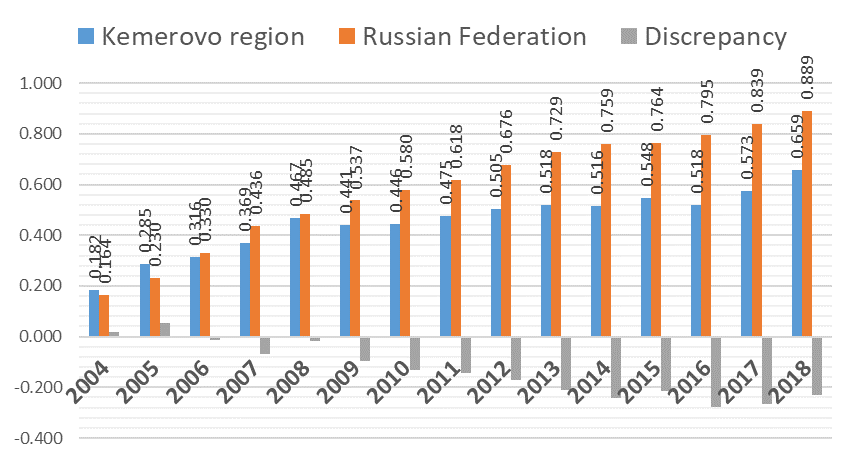
Economy. Production. Finance. Prices
For this block, since 2004, there has been an almost constant increase in the lag of Kemerovo Region’s indicators from the national average values (which reached the peak in 2016–2018 as shown on Figure 2).
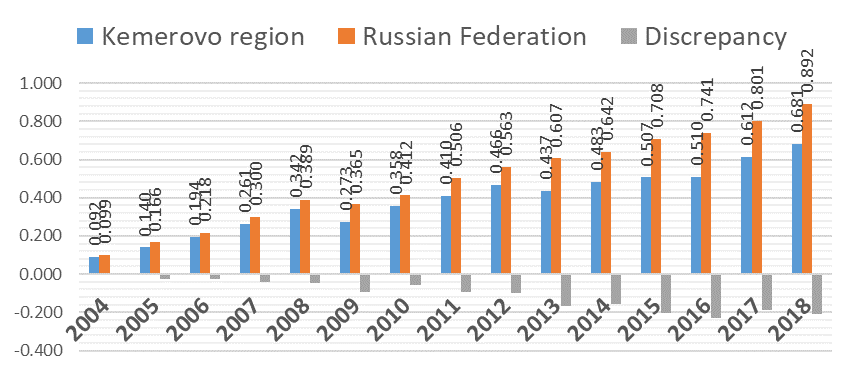
Infrastructure
While the values of “Population” and “Economy. Production. Finance. Prices” blocks for Kemerovo Region were close to the national ones at the beginning of the analyzed period, the region’s indicators for the “Infrastructure” block initially lag significantly behind the average Russian values. The dynamics of this underrun is only increasing over time, reaching a peak in 2016–2018 (see Figure 3).
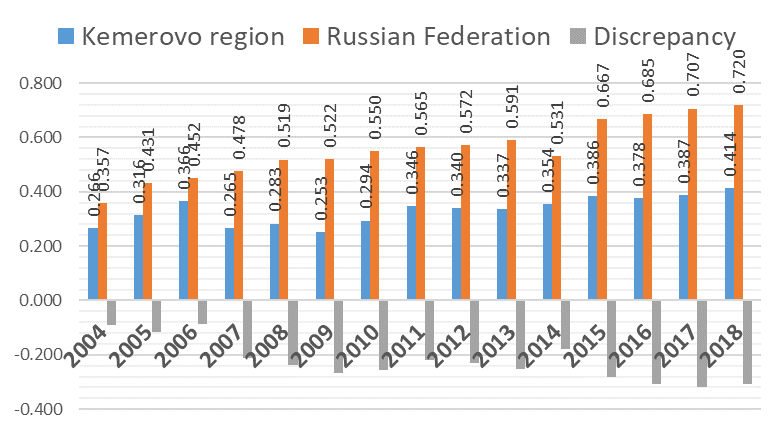
Labour, science and innovation
For this block, there is a steady and significant lag in the development of Kemerovo Region in comparison with the average indicators for Russia, aggravating in 2009–2012 and 2015-2018, which coincided with the peaks of economic crises (Figure 4).
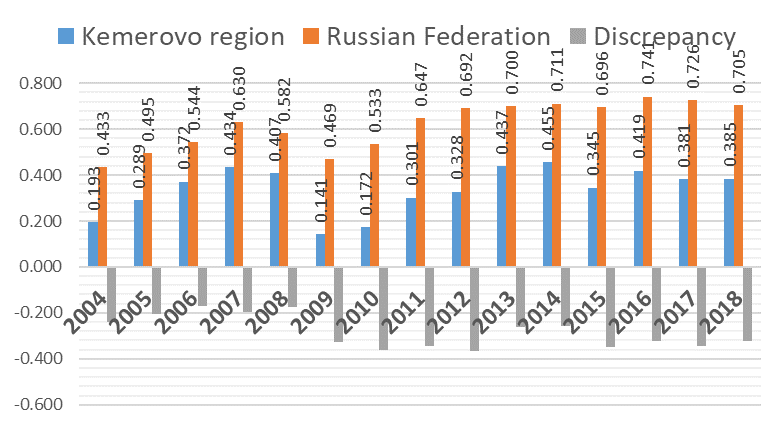
Social aspect. Crime
According to the data presented, the development of social aspects and law enforcement in Kemerovo Region underran the average Russian indicators in 2004–2010. However, since 2011, the situation has improved significantly (regional data on these indicators came closest to the national ones, and in some cases even surpassed them). The exception is 2013, 2018, when the indicators of the social aspect and crime combating showed a slight decrease in the region (see Figure 5).
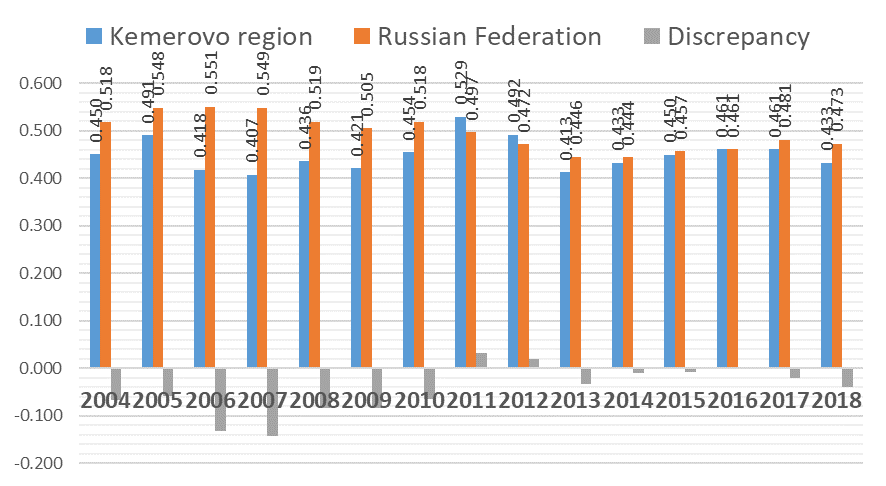
General integral indicator of social and economic development
The calculation of the final indicator revealed a gap in the socio-economic development of Kemerovo Region and the country as a whole observed throughout the analyzed period and tending to increase (from 24% to 30% approximately).
At the same time, indicators of socio-economic development of both Kemerovo Region and the Russian Federation are also steadily increasing. However, the rates of growth of the region’s social and economic spheres in this process prove to be lower. As a result, the underrun of Kemerovo Region from most of the Russian regions will most likely only increase in the future (see Figure 6).
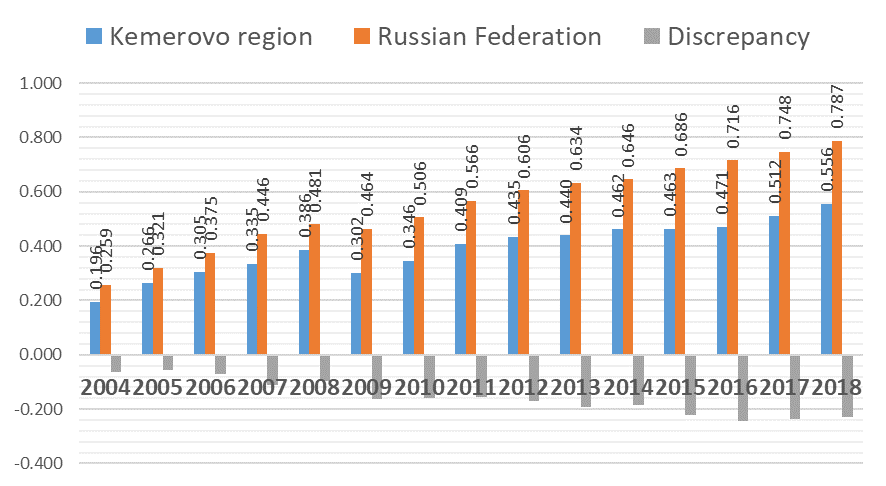
For the purposes of illustrating the situation in Kemerovo Region in comparison with the Russian Federation in general in terms of socio-economic development, a radial diagram was built based on the 2018 data. According to the data, the region is clearly lagging behind in almost all blocks of indicators, except for the development of the social aspects and combating crime (see Figure 7).
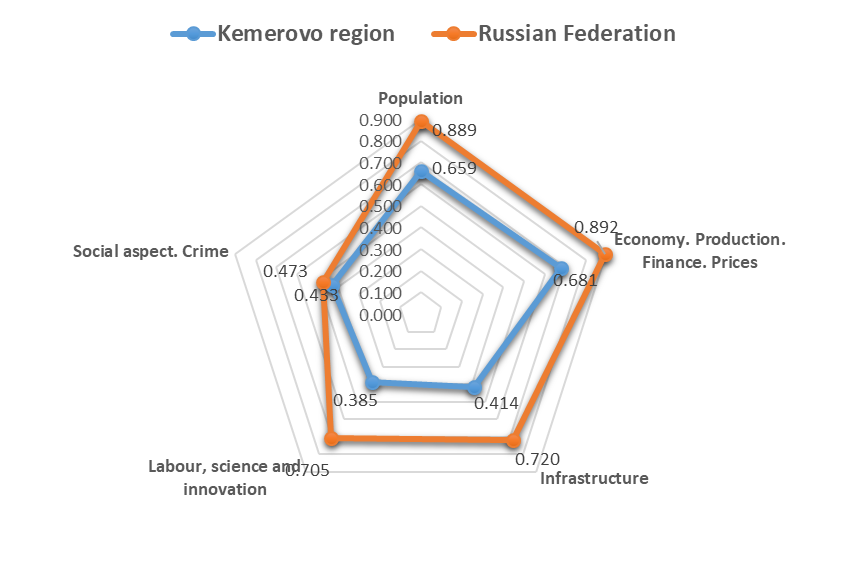
Elimination or attenuation of the identified negative trends requires a competent and efficient social and economic policy, the implementation of scientific-based strategic measures. All the efforts of regional authorities should be directed towards the development of such measures.
Conclusion
The application of an integrated approach for evaluating the region’s level of socio-economic development by means of an efficient combination of sociological and statistical tools, objective and subjective assessments, allows obtaining comprehensive and most reliable information about the analyzed phenomena and processes. The integrated nature of the method proposed here provides a potentially high scientific relevance as the prospects for its application are not limited by the Russian Federation only, they can be expanded over all territories of the world.
Acknowledgments
This paper was supported with an intra-university grant of Kemerovo State University.
References
Arnold, V. N. (1990). Teoriya katastrof [Catastrophic theory]. Nauka.
Ayvazyan, A. (2012). Analiz kachestva i obraza zhizni naseleniya [Analysis of the quality and lifestyle of the population]. CEMI RAN. Nauka.
Bisultanova, A. A. (2017). Choosing an approach to building an economic and mathematical model to predict the social and economic development of regions. Fundamental'nyye i prikladnyye nauchnyye issledovaniya: aktual'nyye voprosy, dostizheniya i innovatsii sbornik statey VII Mezhdunarodnoy nauchno-prakticheskoy konferentsii: v 4 chastyakh [Fundamental and applied research: topical issues, achievements and innovations. Collected papers of the VII International Scientific and Practical Conference, 4, 18-20.
Egorova, I. E., & Kostikova, A. V. (2014). Formalization of expert assessment process in dynamic fuzzy modelling of social and economic indicators of a region and their relationships. Fundamental'nyye issledovaniya [Basic Research], 11(11), 2476-2480.
Eldyaeva, N. A. (2006). Econometric Methods in Macroeconomic Analysis, Vestnik Astrakhanskogo gosudarstvennogo tekhnicheskogo universiteta [Bulletin of Astrakhan State Technical University], 225-230.
Guryeva, M. A. (2015). Forecasting the social and economic development of a country. Teoriya i praktika obshchestvennogo razvitiya [Theory and practice of social development], 10.
Ismikhanov, Z. N., & Magomedbekov, G. U. (2016). Forecasting models of the main social and economic indicators of the region's development. Fundamental'nyye issledovaniya [Basic Research], 10-2, 392-397.
Kleiner, G. B. (2001). Economic and mathematical modelling and economic theory. Ekonomika i matematicheskiye metody [Economics and Mathematical Methods], 3.
Leonenkov, A. (2003). Nechetkoye modelirovaniye v srede MATLAB i fuzzyTECH [Fuzzy modelling in MATLAB and fuzzyTECH]. SPb: BHV-Petersburg.
Morozova, E., Mukhacheva, A., Dobrydina, T., & Usvyat, N. (2018). Recessive Social Trends in the Coal-Mining Region (on Example of Kuzbass) as a Barrier for Sustainable Development. IIIrd International Innovative Mining Symposium, 41.
Mukhacheva, A. V., Morozova, E. A., & Pastukhova, E. Ya. (2019). Social and economic development of the mining region during the crisis (the case of Kemerovo Region). Vestnik Omskogo universiteta. Seriya: Ekonomika [Omsk University Bulletin. Series: Economics], 17(2), 194-206.
Saaty, T. L. (1989). Decision Making. Hierarchy analysis method. Radio and communication.
Zadeh, L. A. (1976). The concept of a linguistic variable and its application to making approximate decisions.: Mir.
Copyright information

This work is licensed under a Creative Commons Attribution-NonCommercial-NoDerivatives 4.0 International License.
About this article
Publication Date
25 September 2021
Article Doi
eBook ISBN
978-1-80296-115-7
Publisher
European Publisher
Volume
116
Print ISBN (optional)
-
Edition Number
1st Edition
Pages
1-2895
Subjects
Economics, social trends, sustainability, modern society, behavioural sciences, education
Cite this article as:
Morozova, E. A., Mukhacheva, A. V., Kiryukhina, A. N., & Logunov, T. A. (2021). Social And Economic Development Of A Region: Issues Of Integrated Modelling. In I. V. Kovalev, A. A. Voroshilova, & A. S. Budagov (Eds.), Economic and Social Trends for Sustainability of Modern Society (ICEST-II 2021), vol 116. European Proceedings of Social and Behavioural Sciences (pp. 373-383). European Publisher. https://doi.org/10.15405/epsbs.2021.09.02.41

